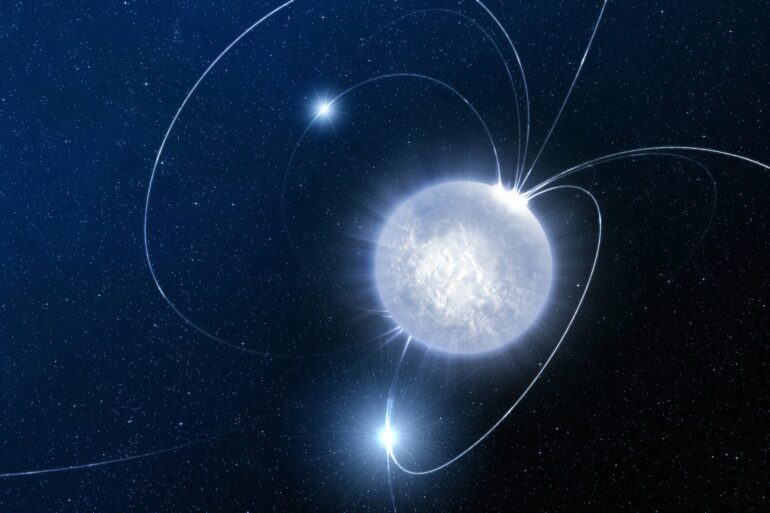Researchers from the University of Turku have determined the geometrical parameters of a neutron star floating in the galaxy 21,000 light years away. The finding confirms old ideas that this star precesses like a whirligig.
X-ray pulsars are strongly magnetized neutron stars powered by accretion of gas from a nearby companion star and are among most prominent sources in the X-ray sky. A new perspective on these objects is now provided by the recently launched International X-ray Polarimeter Explorer (IXPE) space observatory, which started operations at the end of 2021. IXPE measures polarization of X-rays and was used to measure polarization from an X-ray pulsar for the first time, which allowed to constrain its basic geometry.
“Hercules X-1 was the first X-ray pulsar observed by IXPE, and a very low polarization we observed came as a big surprise and that is something we still do not fully understand,” says Victor Doroshenko from the University of Tuebingen in Germany, the lead author of the Nature Astronomy paper.
The average degree of the polarization of about 9% measured by IXPE with very high accuracy turned out to be much lower than optimistically expected 80% by some theoreticians.
“Such a large discrepancy implies that existing models of radiative transport in strongly magnetized plasma confined at the poles of a neutron star and our ideas regarding geometry and structure of the emission region in Hercules X-1 and possibly other pulsars will need to be substantially revised in light of IXPE results,” adds Juri Poutanen from the University of Turku in Finland, leader of the IXPE’s working group studying accreting neutron stars.
Looking at variations of the polarization angle over the spin phase, it was possible to measure the angle between the spin and magnetic dipole axes—a piece of information elemental to any modeling of emission from such objects. Joint modeling of new X-ray polarimetric observations and older optical polarimetric measurements obtained at the Nordic Optical Telescope allowed also to unambiguously show that the spin axis of the pulsar is misaligned with the orbital angular momentum, which is a strong indication that the neutron star precesses like a whirligig.
Free precession of the neutron star was previously invoked to explain observed semi-regular variations of pulsars flux and pulse profile shape with period of ~35 days, and has some important consequences for our understanding of internal structure of neutron stars, but up to now only indirect evidence for this hypothesis is available. The ultimate proof is expected to arrive later when IXPE observes Hercules X-1 at another phase of the precession cycle.
“IXPE is just starting to explore the new observational window, X-ray polarimetry, and we are continuing observations of objects of all kinds, so stay tuned for more surprising discoveries,” says Sergey Tsygankov from the University of Turku, one of the leading authors of the publication.
IXPE was launched on a Falcon 9 rocket from the Cape Canaveral in December 2021, and now orbits 600 kilometers above Earth’s surface. The mission is a collaboration between NASA and the Italian Space Agency with partners and science collaborators in 13 countries including Finland.
More information:
Victor Doroshenko et al, Determination of X-ray pulsar geometry with IXPE polarimetry, Nature Astronomy (2022). DOI: 10.1038/s41550-022-01799-5
Provided by
University of Turku
Citation:
Getting a grip on a strongly magnetized neutron star’s geometry (2022, October 26)
